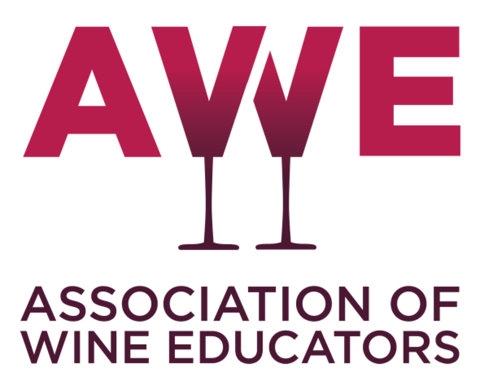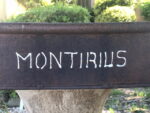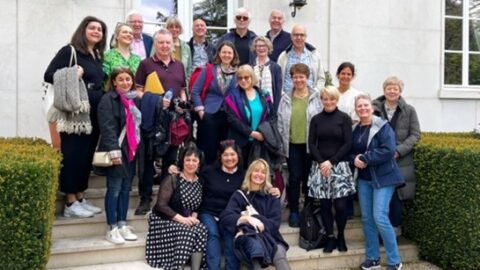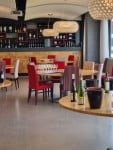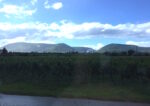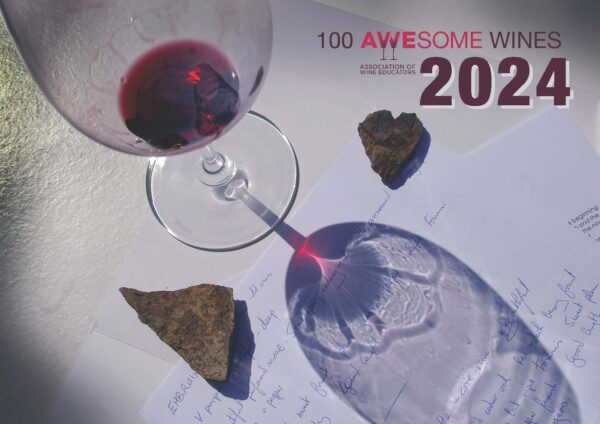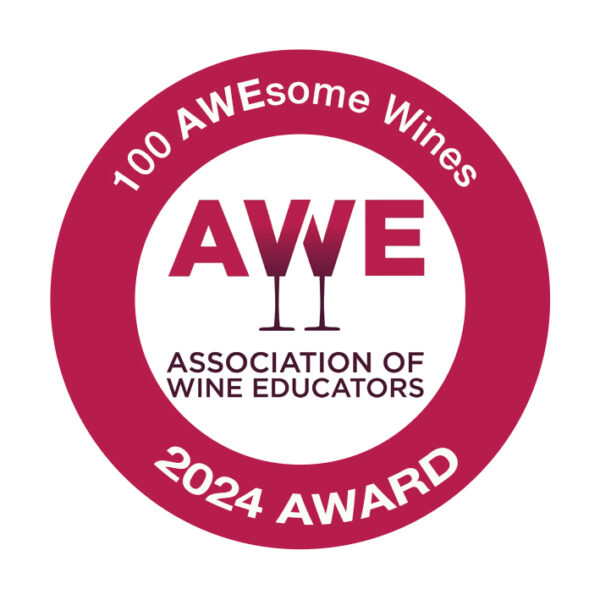Our second visit of the day was to Domaine André Rieffel in the village of Mittelbergheimin the Bas Rhin, where we were to meet two more of the region’s young, passionate and gifted wine makers, Lucas Rieffel and Catherine Riss.
The Rieffels have been vignerons in Mittelbergheim for three generations. They own 10 ha of vines in 3 locations, Barr, Andlau and Mittelbergheim itself. On completion of his training and a spell of work experience in the Burgundy and the New World, Lucas returned to Alsace and gradually took over the management of the domaine from his father in the late 90’s. One of his first initiatives was to go organic. The domaine has been certified organic since 2012 and is now in gradual conversion to biodynamic.
Lucas Rieffel with AWE Group (Picture by Sandy Leckie)
Catherine’s story is rather different. Her family are not vignerons but restaurateurs. It was a fascination with the subtleties of matching wine and food that led her to pursue a career as a wine maker. On completion of her training and work experience, having no family domaine to return to, she found a job as a wine maker with the pioneering, organic wine producer Chapoutier, in the RhôneValley. It was only when the opportunity arose to buy a small (1 ha) vineyard of her own, that she returned to Alsace to become a “neo-vigneronne”, as she put it. She has subsequently been able to take a lease on a further 1.5 ha of bio-dynamically farmed old vines. To begin with, she was indebted to the Rieffel family for their support and encouragement in allowing her space in their winery to make her first Alsace wines. She now has a small winery of her own.
Catherine Riss (Photo by Helen Savage)
Welcoming us, Lucas suggested that we might like a glass of Crémant to refresh our palates after our journey. Crémant was an important part of the domaine’s production and a bit of a speciality, he explained. Having, in the space of less than 24 hours, acquired a bit of a liking for the sparkling wine of Alsace, we readily agreed. But his 2011 ‘L’Emprise’ Extra Brut in magnum was something else again! 80% Pinot Blanc, 10% Pinot Gris and 10% Chardonnay, the base wine spends up to 8 months after fermentation on the lees in big foudres. Malo is encouraged. After bottling, the wine spends a minimum of 18 months ‘sur lattes’ before disgorgement, some being held back for as much as 48 months.
The wine in our glasses was delicious – white flowers on the nose, ripe white peach in the mouth but quite dry with good balancing acidity and a long finish. Why, we wondered, and not for the first time, do we see so little Crémant d’Alsace in the UK? How can it be that we are way down at no.17 in their list of export destinations? I make a mental note to do more to raise the profile of Crémant d’Alsace in the UK. The good news is that Berry Brothers stock a selection of the Rieffels’ wines, including the 2009 Crémant, in magnum.
We then tasted 3 of Catherine’s wines:-
‘Dessous de Table’ 2014 – Co-fermented Auxerrois, Pinot Blanc, Sylvaner and Gewurztraminer, made with minimual use of sulphur. Delicate aromas of stone fruit with just a hint of spice. An elegant, dry and quite rich wine that would make a stylish aperitif or go well with grilled river fish or crab.
Riesling ‘Schieferberg’ 2013 – A very pure, delicate dry Riesling made from grapes grown on schistous soils, again with minimal use of sulphur. Although this wine had less than one gram of residual sugar it was perfectly balanced and would be a great match for steamed or grilled white fish. The lieu-dit Schieferberg is a candidate for promotion to 1er cru.
‘Empreinte’ Pinot Noir 2014 – Made from grapes from parcels of vines growing on schistous and sandstone based soils with whole-bunch fermentation and zero use of sulphur. A light, bright, ruby coloured wine with attractive red-fruit aromas and flavours, this would work well, served lightly chilled with smoked or salt-cured meats or with magret de canard, perhaps?
Catherine sells most of her wines to high-end restaurants, of which there are plenty in Alsace. Sadly, they are not available in the UK at the present time.
Then it was back to Lucas. We tasted 9 wines from the Rieffel range.
Pinot Noir “Kreuzel” 2013 – Lucas sees no reason why Pinot Noir can’t work as well in Alsace as in Burgundy and, on the basis of this sample at least, he is clearly on the right lines. Deep ruby in colour with attractive raspberry/red cherry aromas and flavours and good tannic structure – more Côte de Beaune than Côte de Nuits, perhaps, but very Burgundian in style.
Pinot Blanc “Gebreit” 2013 – This wine spends a year in old oak, which gives it a rich, creamy texture without detracting from the white flower aromas and peachy fruit character of the variety.
A trio of classic dry Rieslings made a fascinating centrepiece to the tasting. What impressed most about these wines was the purity of the fruit aromas and flavours and the balance between the fruit and the high acidities that Riesling delivers. These were vibrant, crisp, dry wines, “racy” but in no way steely.
Riesling”Brandluft” 2013 – From a plot of sandy clay and limestone above the village of Mittelbergheim. White flowers, zingy citrus fruit with hint of sherbet in the finish. Delicious now as an aperitif but would reward keeping.
Riesling Grand Cru “Wiebelsberg” 2012– From old vines on a steep, south-facing slope of red sandstone above the village of Andlau. Concentrated citrus fruit. More Lime than lemon this time, with plenty of ripeness to balance the naturally high acidity. Great ageing potential.
Riesling Grand Cru “Zotzenberg” 2012 – From a plot of clay and limestone above the village of Barr. Concentrated citrus fruit. Grapefruit peel this time, with plenty of ripeness to balance the naturally high acidity. A hint of spice in the finish. Again, a wine with great ageing potential.
As Lucas explained to us, you need to understand the variety to make great wine from Sylvaner. It’s a naturally vigorous variety and, grown on fertile soil, will yield 70 or even 80 hectolitres per hectare of bland, sugary juice fit only for conversion into ‘jug’ wine. Restricting the yield is key.
Sylvaner Grand Cru “Zotzenberg” 2013 – Of all the 51 grand cru vineyards in Alsace, Zotzenberg is alone in recognising the real merits of Sylvaner. This one comes from 50 to 60 year old vines growing on a south facing slope. Peachy aromas and flavours but with plenty of grip. Mineral notes and acidity give the wine structure and ageing potential. Lucas suggests Sylvaner can be as age-worthy as Riesling!
Riesling Grand Cru “Wiebelsberg”Vendange Tardive 2011 – Wonderfully rich, ripe, concentrated, sweet fruit but, once more, with crisp, balancing acidity, which stops it from being cloying.
And finally, to Gewurztraminer. According to the marketing people, it’s a wine to go with spicy food, but, for me, well made Gewurz deserves a better fate. I certainly would never recommend serving any of the Rieffel wines with anything the slightest bit hot on the palate.
Gewurztraminer Grand Cru “Zotzenberg” 2012 – Rosewater, lychee, mango…..the classic aromas and flavours but very delicate. Just off dry, but with plenty of acidity to balance the ripe sweetness of fruit. I think I would enjoy a glass of this nectar, slightly chilled, on its own, as an aperitif.
Gewurztraminer Grand Cru”Zotzenberg” Vendange Tardive 2011 – A lusciously sweet wine. The essence of Gewurz. Best enjoyed slowly, with good friends, at the end of a fine meal, I would suggest. But if, by any chance, you are still hungry, I could see this working well with a slice of one of those seasonal fruit tarts which are such a speciality of Alsace.
What a way to end a very special tasting of wines from two such talented wine makers!
